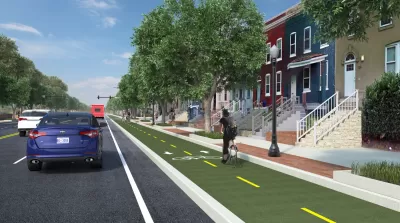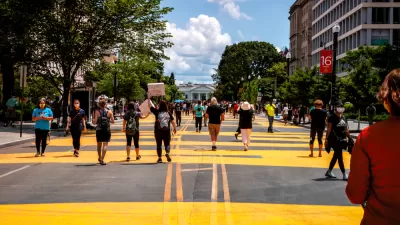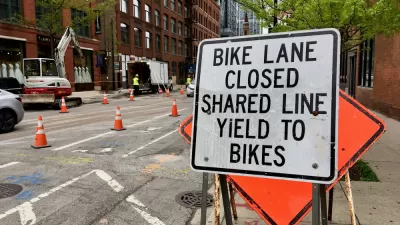Vision Zero is an ambitious goal, but it's impossible if traffic safety ideas aren't tested and implemented on the street.

Andrew Small reports from D.C., where the District Department of Transportation (DDOT) finally seems to be making progress on traffic safety programs after years of delays and frustration among Vision Zero boosters in the District.
Last year, the news three years into DDOT's Vision Zero was not good: "By that point in the year, 34 people overall had died on the city’s roads—D.C.’s worst year for traffic deaths in a decade," according to Small. Meanwhile projects were still several months away in the development pipeline and members of the District Council were getting frustrated with DDOT officials at a public hearing.
Fast forward to November 2019, and it's possible to report some progress. "In 2019, DDOT established a Vision Zero Office, fast-tracked quick-build safety projects like adding plastic pylons at crosswalks to slow drivers turns, and piloted some new ideas, such as dedicated bus lanes or painted curb extensions, that could be executed with little more than a can of paint," reports Small. The traffic safety statistics have also improved: "So far, 21 people have died from road crashes this year in the District, putting the city on track for the lowest number of traffic fatalities since the city committed to Vision Zero in 2015."
The article includes a lot more detail on the local political context for Vision Zero, the projects moving the needle for traffic safety, and the challenges for a true commitment to traffic safety, beyond the positive public relations benefit of announcing a Vision Zero campaign.
FULL STORY: Are D.C.'s Streets Finally Getting Safer?

Alabama: Trump Terminates Settlements for Black Communities Harmed By Raw Sewage
Trump deemed the landmark civil rights agreement “illegal DEI and environmental justice policy.”

Planetizen Federal Action Tracker
A weekly monitor of how Trump’s orders and actions are impacting planners and planning in America.

The 120 Year Old Tiny Home Villages That Sheltered San Francisco’s Earthquake Refugees
More than a century ago, San Francisco mobilized to house thousands of residents displaced by the 1906 earthquake. Could their strategy offer a model for the present?

In Both Crashes and Crime, Public Transportation is Far Safer than Driving
Contrary to popular assumptions, public transportation has far lower crash and crime rates than automobile travel. For safer communities, improve and encourage transit travel.

Report: Zoning Reforms Should Complement Nashville’s Ambitious Transit Plan
Without reform, restrictive zoning codes will limit the impact of the city’s planned transit expansion and could exclude some of the residents who depend on transit the most.

Judge Orders Release of Frozen IRA, IIJA Funding
The decision is a victory for environmental groups who charged that freezing funds for critical infrastructure and disaster response programs caused “real and irreparable harm” to communities.
Urban Design for Planners 1: Software Tools
This six-course series explores essential urban design concepts using open source software and equips planners with the tools they need to participate fully in the urban design process.
Planning for Universal Design
Learn the tools for implementing Universal Design in planning regulations.
Clanton & Associates, Inc.
Jessamine County Fiscal Court
Institute for Housing and Urban Development Studies (IHS)
City of Grandview
Harvard GSD Executive Education
Toledo-Lucas County Plan Commissions
Salt Lake City
NYU Wagner Graduate School of Public Service





























